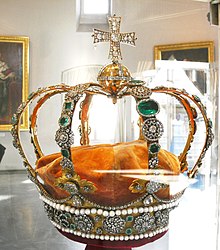Frederick I of Württemberg


Frederick I (German: Friedrich I. Wilhelm Karl; November 6, 1754 – October 30, 1816) was the first King of Württemberg. He was known for his size, 2.11 m (6 ft 11 in) and about 200 kg (441 lb/30 st 7 lb), which put him in contrast to Napoleon who recognized him as King of Württemberg.
Biography
Born in Treptow, Frederick was the eldest son of Duke Friedrich Eugen of Württemberg and Sophia Dorothea of Brandenburg-Schwedt. Friedrich's father was the third son of Duke Karl Alexander, and Friedrich was thus the nephew of the long-reigning duke Karl Eugen. Since neither Karl Eugen nor his next brother, Ludwig Eugen had any sons, it was expected that Friedrich would eventually succeed to the Duchy.

On 22 December 1797, Friedrich's father, who had succeeded his brother as Duke of Württemberg two years before, died, and Friedrich became Duke of Württemberg as Friedrich III. He was not to enjoy his reign undisturbed for long, however. In 1800, the French army occupied Württemberg and the Duke and Duchess fled to Vienna. The following year, Duke Friedrich concluded a private treaty ceding Montbéliard, an enclave within the boundaries of France, to the French Republic, and received Ellwangen in exchange two years later.
According to the Reichsdeputationshauptschluss, which reorganized the Empire as a result of the French annexation of the Left Bank of the Rhine, the Duke of Württemberg was raised to the dignity of Imperial Elector. Friedrich assumed the title Prince-Elector (Kurfürst) 25 February 1803, and was thereafter known as the Elector of Württemberg. The reorganization of the Empire also secured the new Elector control of various ecclesiastical territories and former free cities, thus greatly increasing the size of his domains.
In exchange for providing France with a large auxiliary force, Napoleon recognized the Elector as King of Württemberg on 26 December 1805. Friedrich became King Friedrich I when he formally ascended the throne on 1 January 1806 and was crowned as such on the same day at Stuttgart. Soon after, Württemberg seceded from the Holy Roman Empire and joined Napoleon's Confederation of the Rhine. Once again, the assumption of a new title also meant territorial expansion, as the territories of various nearby princes were mediatized and annexed by Württemberg. As a symbol of his alliance with the French Emperor, Friedrich's daughter Catherine was married to Napoleon's youngest brother Jerome. The newly elevated king's alliance with France technically made him the enemy of his father-in-law, British King George III. However, the King's dynastic connections would enable him to intermittently act as a go between between the British government and various continental powers.
During the War of Liberation in 1813, Friedrich changed sides and went over the Allies, where his status as the brother-in-law of the Prince Regent (later George IV) and uncle to Tsar Alexander I helped his standing. After the fall of Napoleon, he attended the Congress of Vienna and was confirmed as King. At Vienna Friedrich and his ministers were very concerned to make sure that Württemberg would be able to retain all the territories it had gained in the past fifteen years. Friedrich's harsh treatment of the mediatized princes within his domain made him one of the principal targets of the organization of dispossessed princes, which hoped to gain the support of the Powers in regaining their lost sovereignty. In the end, however, Austria, which was seen as the natural ally of the princes, was more interested in alliance with the medium sized German states like Württemberg than with asserting its traditional role as protector of the smaller sovereigns of the old Empire, and Friedrich was allowed to retain his dubiously acquired lands. Friedrich, along with the other German princes, joined the new Germanic Confederation in 1815. He died in October of the next year.
When he became King, he styled his children and further male-line descendants as HRH Princes and Princesses of Württemberg, and he styled his siblings as Royal Highnesses and Dukes and Duchesses of Württemberg.
He was very tall and obese: behind his back he was known as "The Great Belly-Gerent". Napoleon I of France remarked that God had created the Prince to demonstrate the utmost extent to which the human skin could be stretched without bursting. In return, Friedrich wondered how so much poison could fit in such a small head.
Marriage and children

On 15 October 1780, 25-year-old Duke Friedrich married Duchess Augusta of Brunswick-Wolfenbüttel, eldest daughter of Charles William Ferdinand, Duke of Brunswick-Lüneburg and Princess Augusta of Great Britain, the sister of George III of the United Kingdom. They had four children before Augusta's premature death in 1788:
- Wilhelm (1781-1864), who would later succeed his father as King Wilhem I;
- Catherine (1783-1835); and
- Sophia (1783-1784)
- Paul (1785-1852);
Frederick's second marriage made his connection to the British royal family even stronger: at St. James's Palace on 18 May 1797 he married Charlotte, Princess Royal of Great Britain, the eldest daughter of King George III and Queen Charlotte. They had only one child, a stillborn daughter, born and died on April 271798.
In 2008 it was discovered that the current Mayor of London, Boris Johnson is descended from Friedrich through Prince Paul.
Ancestry
| Family of Frederick I of Württemberg | ||||||||||||||||||||||||||||||||||||||||||||||||||||||||||||||||||||||||||||||||||||||||||||||||||||||||||||||||||||||||||||||||||||||||||||||||||||||||||||||||||||||||||||||||||||||||||||||||||||||||||||||||||||||||||||||||||||||||||||||||||||||||||||||||||||||||||||||||||||||||||||||||||||||||||||||||||||||||||||||||||||||||||||||||||||||||||||||||||||||||||||||||||||||||||||||||||||||||||||||||||||||||||||||||||||||||||||||||||||||||||||||||||||||||||||||||||||||||||||||||||||||||||||||||||||||||||||||||||||||||||||||||||||||||||||||||||||||||||||||||||||||||||||||||||||||||||||||||
|---|---|---|---|---|---|---|---|---|---|---|---|---|---|---|---|---|---|---|---|---|---|---|---|---|---|---|---|---|---|---|---|---|---|---|---|---|---|---|---|---|---|---|---|---|---|---|---|---|---|---|---|---|---|---|---|---|---|---|---|---|---|---|---|---|---|---|---|---|---|---|---|---|---|---|---|---|---|---|---|---|---|---|---|---|---|---|---|---|---|---|---|---|---|---|---|---|---|---|---|---|---|---|---|---|---|---|---|---|---|---|---|---|---|---|---|---|---|---|---|---|---|---|---|---|---|---|---|---|---|---|---|---|---|---|---|---|---|---|---|---|---|---|---|---|---|---|---|---|---|---|---|---|---|---|---|---|---|---|---|---|---|---|---|---|---|---|---|---|---|---|---|---|---|---|---|---|---|---|---|---|---|---|---|---|---|---|---|---|---|---|---|---|---|---|---|---|---|---|---|---|---|---|---|---|---|---|---|---|---|---|---|---|---|---|---|---|---|---|---|---|---|---|---|---|---|---|---|---|---|---|---|---|---|---|---|---|---|---|---|---|---|---|---|---|---|---|---|---|---|---|---|---|---|---|---|---|---|---|---|---|---|---|---|---|---|---|---|---|---|---|---|---|---|---|---|---|---|---|---|---|---|---|---|---|---|---|---|---|---|---|---|---|---|---|---|---|---|---|---|---|---|---|---|---|---|---|---|---|---|---|---|---|---|---|---|---|---|---|---|---|---|---|---|---|---|---|---|---|---|---|---|---|---|---|---|---|---|---|---|---|---|---|---|---|---|---|---|---|---|---|---|---|---|---|---|---|---|---|---|---|---|---|---|---|---|---|---|---|---|---|---|---|---|---|---|---|---|---|---|---|---|---|---|---|---|---|---|---|---|---|---|---|---|---|---|---|---|---|---|---|---|---|---|---|---|---|---|---|---|---|---|---|---|---|---|---|---|---|---|---|---|---|---|---|---|---|---|---|---|---|---|---|---|---|---|---|---|---|---|---|---|---|---|---|---|---|---|---|---|---|---|---|---|---|---|---|---|---|---|---|---|---|---|---|---|---|---|---|---|---|---|---|---|---|---|---|---|---|---|---|---|---|---|---|---|---|---|---|---|---|---|---|---|---|---|---|---|---|---|---|---|---|---|---|---|---|---|---|---|---|---|---|---|---|---|---|---|---|---|---|---|---|---|---|---|---|---|---|---|---|---|---|---|---|---|---|---|---|---|---|---|---|---|---|---|---|---|---|---|---|---|---|---|---|---|---|---|---|---|---|---|---|---|---|---|---|---|---|---|---|---|---|---|---|---|---|---|---|---|---|---|---|---|---|---|---|---|---|---|---|---|---|
| ||||||||||||||||||||||||||||||||||||||||||||||||||||||||||||||||||||||||||||||||||||||||||||||||||||||||||||||||||||||||||||||||||||||||||||||||||||||||||||||||||||||||||||||||||||||||||||||||||||||||||||||||||||||||||||||||||||||||||||||||||||||||||||||||||||||||||||||||||||||||||||||||||||||||||||||||||||||||||||||||||||||||||||||||||||||||||||||||||||||||||||||||||||||||||||||||||||||||||||||||||||||||||||||||||||||||||||||||||||||||||||||||||||||||||||||||||||||||||||||||||||||||||||||||||||||||||||||||||||||||||||||||||||||||||||||||||||||||||||||||||||||||||||||||||||||||||||||||
Literature
- Paul Sauer: Der schwäbische Zar. Friedrich - Württembergs erster König. Stuttgart 1984.
- Ina Ulrike Paul: Württemberg 1797–1816/19. Quellen und Studien zur Entstehung des modernen württembergischen Staates (= Quellen zu den Reformen in den Rheinbundstaaten Bd. 7). München 2005.
